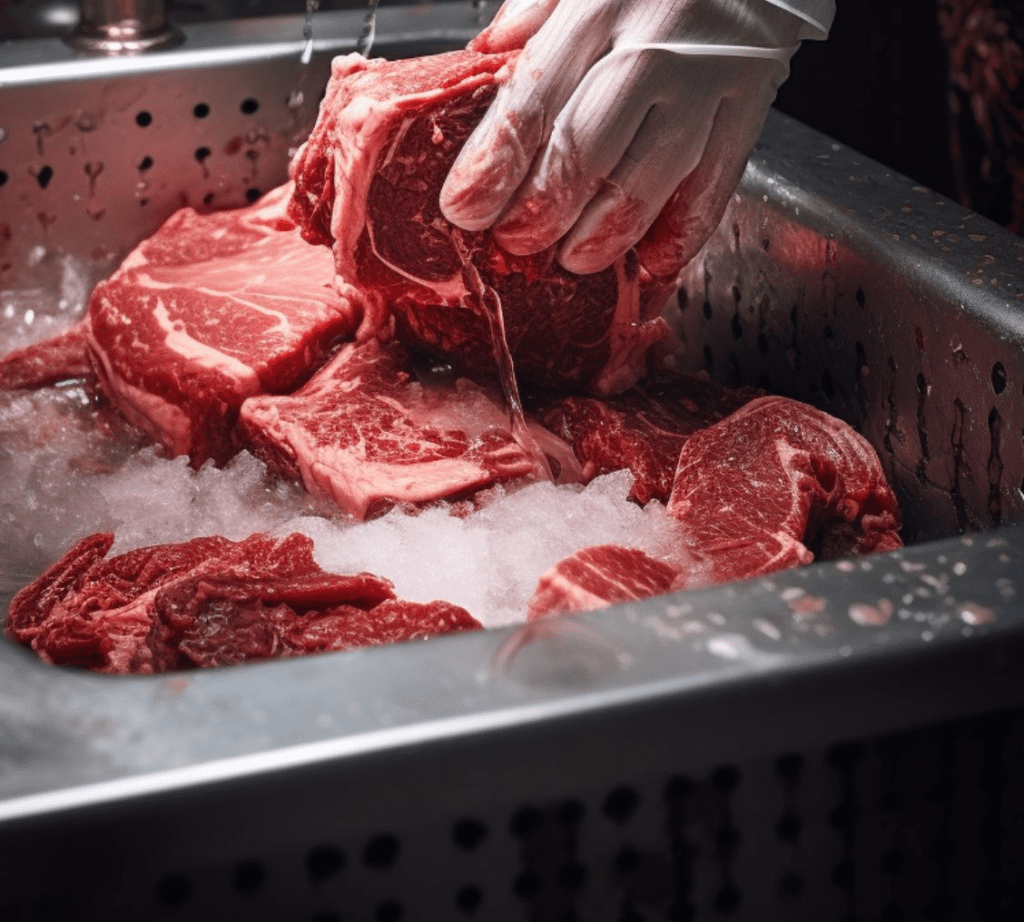Defrosting meat might seem like a simple kitchen task, but doing it incorrectly can lead to serious health risks. One of the most common questions people have is whether it’s safe to defrost meat in hot water. While it may seem like a quick fix, defrosting meat in hot water comes with several dangers that you should be aware of. Let’s break down everything you need to know about defrosting meat safely and why hot water is not your best option.
Understanding the Dangers of Defrosting Meat in Hot Water

When it comes to defrosting meat, the biggest concern is bacterial growth. Harmful bacteria like Salmonella and E. coli can grow rapidly if the meat isn’t handled properly. The key issue with using hot water is that it can create the perfect environment for these bacteria to multiply. Here’s why.
The Science Behind the Danger Zone
The “danger zone” refers to temperatures between 40°F and 140°F, where bacteria can thrive. When you submerge meat in hot water, it can quickly enter this danger zone, allowing bacteria to multiply. Food safety guidelines emphasize that meat should not stay in this temperature range for more than two hours. Unfortunately, hot water causes the outer layers of meat to reach unsafe temperatures long before the interior is thawed.
Surface Bacterial Growth: The Risk with Hot Water
When meat is placed in hot water, the surface of the meat warms up faster than the inside. This leads to uneven thawing, with the outer layers entering the danger zone while the center remains frozen. Once the meat’s surface reaches this temperature range, bacteria can double in number every 20 minutes. This can pose a significant health risk, even if the meat is cooked thoroughly later on.
Inconsistent Temperatures Lead to Unsafe Thawing
Another problem with using hot water is that the temperature isn’t stable. Once the meat is added to the water, the temperature drops, leading to inconsistent thawing. The uneven heat distribution can make it difficult to keep the entire piece of meat out of the danger zone, further increasing the risk of bacterial growth. The longer the meat stays in this unsafe temperature range, the more bacteria can multiply, making it a risky method for thawing.
Safer Alternatives for Defrosting Meat
Given the risks associated with defrosting meat in hot water, it’s essential to explore safer alternatives. Let’s look at three methods that are recognized as safe by food safety experts.
Refrigerator Thawing: The Safest Option
Refrigerator thawing is the gold standard for defrosting meat. Although it takes longer—up to 24 hours for larger cuts—this method keeps meat at a safe, consistent temperature. The meat never enters the danger zone, ensuring that harmful bacteria don’t get a chance to multiply. Plus, once thawed, the meat can stay in the refrigerator for an extra day or two before cooking, giving you added flexibility in meal prep.
Cold Water Thawing: A Faster, Safe Alternative
If you’re pressed for time, cold water thawing is a faster method that’s still safe if done correctly. Place the meat in a leakproof plastic bag and submerge it in cold water. Make sure to change the water every 30 minutes to keep it cold enough and prevent the meat from entering the danger zone. This method can thaw smaller cuts of meat in a few hours, offering a quicker solution without compromising safety.
Microwave Thawing: Quick but Requires Caution

Microwave thawing is another speedy option, but it comes with its own set of challenges. Microwaves can defrost unevenly, leading to some parts of the meat partially cooking while others remain frozen. If you use the microwave, make sure to cook the meat immediately after thawing, as some sections may have reached temperatures that encourage bacterial growth. It’s a fast method, but you need to act quickly to ensure safety.
Key Takeaways for Safe Meat Thawing
While defrosting meat in hot water might seem like a time-saving trick, it’s generally not worth the risk. Let’s summarize the key points to remember for safe meat thawing:
- Avoid the Danger Zone: Meat should never stay between 40°F and 140°F for more than two hours. Hot water can push meat into this unsafe range quickly, allowing bacteria to multiply.
- Refrigerator Thawing Is Best: If you have time, always opt for thawing meat in the refrigerator. It’s the safest method and ensures the meat stays at a safe temperature throughout the process.
- Cold Water Thawing for Faster Results: If you’re in a rush, use cold water thawing. Make sure to change the water regularly to keep it cold enough to prevent bacterial growth.
- Use Caution with Microwaves: Microwave thawing can be convenient, but it often leads to uneven thawing. Cook meat immediately after microwaving to ensure bacteria don’t have a chance to grow.
Conclusion: Safe Thawing Equals Safe Eating

In the end, defrosting meat properly is all about food safety. While defrosting in hot water might seem like a shortcut, it can lead to bacterial contamination that compromises the safety of your food. By understanding the risks and choosing safer alternatives like refrigerator or cold water thawing, you can ensure your meals are both delicious and safe to eat. The extra time it takes to thaw meat properly is well worth it, as it can make the difference between a healthy meal and a dangerous one.
When it comes to defrosting meat, always prioritize safety and opt for methods that keep your food out of the danger zone.